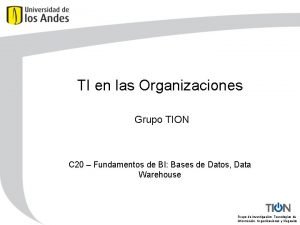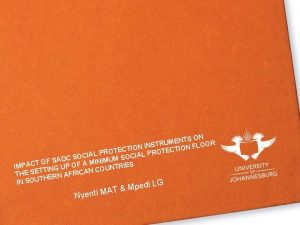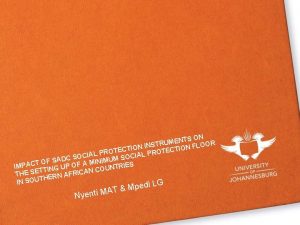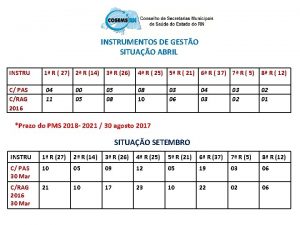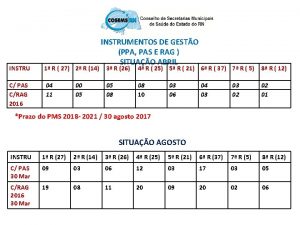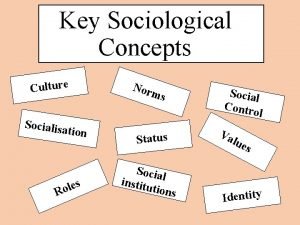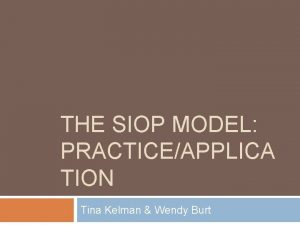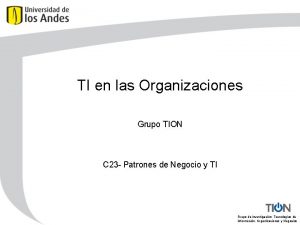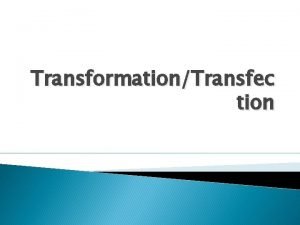S ON T N E M INSTRU TION




























- Slides: 28

S ON T N E M INSTRU TION FLOOR N O I T C PROTE CIAL PROTEC L A I C ADC SO MINIMUM SO S F O T OF A P IMPAC U NTRIES U G N O I C T T N THE SE ERN AFRICA TH IN SOU LG edi Nye Mp & T A M nti

OUTLINE 1. Introduction 2. The minimum social protection floor concept 3. Social protection instruments and the ‘social security staircase’ 4. A minimum social protection floor for the SADC region 5. Social protection in SADC countries: Coverage, successes and challenges. 6. Some concluding observations

1. INTRODUCTION § Mission of SADC is to promote sustainable and equitable economic growth and socio-economic development through efficient productive systems, deeper cooperation and integration, good governance, and durable peace and security § Various instruments have been concluded to achieve SADC’s mission of achieving socio-economic development, including : § Declaration and Treaty of SADC (the SADC Treaty) § Charter of Fundamental Social Rights in the SADC (social Charter) § Code on Social Security § Code on HIV/AIDS and Employment § Protocol on Gender and Development § Protocol on Health

§ Social protection instruments aim at setting standards for the coordination, convergence and harmonisation of social security systems in the SADC region. § Instrument also seek to ensure baseline standards (a minimum floor) at the regional and country level with regard to the social protection functions that a state has to implement § Therefore, instruments could be said to promote the establishment of a minimum social protection floor in the region § An evaluation of the effectiveness of SADC social protection instruments require an understanding of what the minimum social protection floor concept entails; and its implications (also in the peculiar (Southern) African context).

THE MINIMUM SOCIAL PROTECTION FLOOR CONCEPT § No universal definition has been proposed for the minimum social protection floor § Concept proposed by the World Commission on the Social Dimension of Globalization in 2004, when it stated that: “a certain minimum level of social protection needs to be an accepted and undisputed part of the socio-economic floor of the global economy. ” § Concept as developed by the ILO denotes a set of basic social rights, services and facilities to which the global citizen should have access. Consists of a basic set of social security entitlements that are provided in addition to social insurance schemes § Concept is premised on the basis that it can be realised through the provision of social transfers and essential services.

§ Access to these social transfers and essential services must be as of a right § An appropriate legislative framework must thus be developed or any existing framework amended to uphold and protect the rights of those likely to be affected § Rights and services provided should be at the minimum essential levels of rights as provided in human rights treaties § Rights and services include a basic set of essential transfers, in cash and in kind, paid to the poor and vulnerable to provide a minimum income security and access to essential health care; and geographical and financial access to essential services such as water and sanitation, adequate nutrition, and education

§ Minimum floor guarantees access to nationally-defined baskets of essential goods, services, and income transfers that ensure that people are not hungry, do not suffer from treatable illnesses, do not remain uneducated, do not have to resort to unsafe water, and do not remain homeless § Effective access to the goods and services should be guaranteed for all, throughout the life cycle: § Universal access to essential health services for all residents; § Income (or subsistence) security for all children through child benefits; § Income support combined with employment guarantees through public works programmes for the working-age poor; and, § Income security through basic tax-financed pensions for the old, the disabled and survivors/dependents

§ Basic set of essential transfers must be in addition to mandatory social insurance and voluntary insurance schemes

§ Social protection floor concept can be developed and implemented at both the international, regional and national contexts. SOCIAL PROTECTION FLOOR INTERNATIONAL ORGANISATIONS UNO, WHO and ILO REGIONAL ORGANISATION SADC NATIONAL Ang, Bot, DRC, Les, Mad, Mal, Mau, Moz, Nam, Sey, RSA, Swa, Tan, Zam and Zim

§ However, the concept cannot be applied uniformly across the world, due to differences in national or regional experiences. § Therefore, it is required that the concept should remain general and flexible and take into account national (or regional) context and capacity. § The scope of the concept should be subject to national or regional debate and to progressive implementation. § Particular attention should also be paid to vulnerable groups through consideration of further key characteristics that cut across all age groups (including gender, socio-economic status, ethnicity, disabilities, population exposed and/or highly sensitive to adverse external effects such as natural hazards, intense climate phenomena

A MINIMUM SOCIAL PROTECTION FLOOR FOR THE SADC REGION FOUR ESSENTIAL GUARANTEES SOCIAL PROTECTION RELEVANT ARTICLES INSTRUMENTS Access to essential health care Social Charter Article 12 (Protection of health, safety and environment) Code on Social Security Article 7 (Provision of health care services) Protocol on Health All (Collaboration on health)

A MINIMUM SOCIAL PROTECTION FLOOR FOR THE SADC REGION (CONT’D) Income Children security: Social Charter Code on Security Assistance: Unemployed and poor Social Charter Code on Security Article 7 (Protection of children and young people) Social Article 16 (Protection of children and young persons) Article 10(2) Social Article 11 (Protection against un-/underemployment)

A MINIMUM SOCIAL PROTECTION FLOOR FOR THE SADC REGION (CONT’D) Income security: Elderly and persons with disabilities Social Charter Article 8 and Article 9 (Social and labour law protection of elderly persons; and Social and labour law protection of persons with disabilities) Code on Social Security Article 10 and Article 14 (Protection for the elderly and persons with disabilities)

A MINIMUM SOCIAL PROTECTION FLOOR FOR THE SADC REGION (CONT’D) CONTRIBUTORY SCHEMES SOCIAL PROTECTION INSTRUMENTS Voluntary insurance Social Charter Code on Security Mandatory social insurance Social Charter Code on Security RELEVANT ARTICLES Article 10(1) (Establishment of social insurance schemes) Social Article 6 (Establishment of social insurance schemes and provision of benefits) Article 10(1)(Establishment of social insurance schemes) Social Article 6 (Establishment of social insurance schemes and provision of benefits)

§ Social Charter makes provision for the establishment of harmonised minimum country social protection programmes in the SADC region. § It also adopts a flexible approach, similar to the approach proposed in the minimum social protection floor concept (and in other international and/or multilateral instruments). § Such a flexible approach is consistent with the SADC principle of variable geometry, i. e. the principle, according to which a group of member states could move faster on certain activities and the experiences learnt are replicated in other member states.

§ Code on Social Security in the SADC § The Code contains general principles and minimum standards of social protection, and a framework for monitoring at national and regional levels § It provides member states with strategic direction and guidelines in the development and improvement of social security schemes § It also provides SADC and member states with an effective instrument for the coordination, convergence and harmonisation of social security systems in the region. § The Code employs concepts and principles which reflect the reality of the SADC region and which are flexible (also incorporates the principle of variable geometry).

SOCIAL PROTECTION IN SADC COUNTRIES: COVERAGE, SUCESSES AND CHALLENGES § Access to essential health care § Health care in SADC countries largely provided through a two tiered system (private and public sectors). § Good private health care but restricted access due to high costs § Access generally through private health insurance policy or contribution towards a medical aid scheme § Public health care generally financed through taxes and, to a lesser extent, user-fees.

§ Although mostly relied on by persons who cannot afford private health care, public health systems are often challenged by inadequate infrastructure and a shortage of skilled personnel. § Also inaccessible to the poor as they largely located in rural or remote areas § However, public health systems play a crucial role in the testing and treatment of HIV/Aids, particularly in dispensing of free antiretroviral (ARVs) § Some SADC countries render free health care (such as free primary health care to children under six and pregnant women in South Africa) while other waive user fees for indigent persons (such as in Tanzania (Mainland), for the treatment of children below the age of five and diseases such as tuberculosis and AIDS)

§ Access to essential health care is further compounded by the lack of National Health Insurance systems in a majority of SADC countries. § As a result, there is a proposal in South Africa in favour of a national health insurance scheme. § Income security for Children § There are social protection programmes targeted at orphans and vulnerable children in many SADC countries § Programmes include social assistance benefits and other social services

§ Programmes targeting children in selected SADC countries COUNTRY Botswana Mozambique South Africa Zambia SOCIAL SECURITY BENEFITS/SOCIAL SERVICES Orphan Care Benefit Minimum Income for School Attendance (Pilot programme). Child Support Grant Care Dependency Grant Foster Care Grant Social Relief of Distress Child Protection Programme

§ The value of the social security benefits aimed at children is generally low in the region. § However, a general trend has emerged in the last few years whereby some SADC countries have progressively increased the monetary value of the benefits. § Furthermore, some countries are progressively extending the age of eligibility of some of their children’s grants (E. g. South Africa’s child support grant which will be gradually extended to children up to their 18 th birthday with effect from 1 January 2010

§ Assistance to the unemployed and poor § Social assistance rendered to the unemployed and the poor is limited in SADC countries. § Apart from the Unemployment Hardship Relief in Mauritius (noncontributory benefit programme aimed at unemployment) none of the other SADC countries has an unemployment assistance programme. § Although provision is made in labour laws for severance pay, this is not and should not be viewed as a substitute for proper unemployment benefits

§ In the absence of unemployment assistance schemes, universal or means-tested non-contributory schemes (where in existence) play an indirect unemployment assistance role as they are shared with other needy individuals living with the beneficiaries. § However, this has the effect of diluting the poverty alleviation impact of the benefits to the intended beneficiaries. § Therefore, it is important that the scope of coverage of the noncontributory schemes be progressively widened to cover more needy members of the society.

§ Income security: Elderly and persons with disabilities § Two kinds of non-contributory schemes are identifiable in the SADC region, i. e. : universal programmes (e. g. in Botswana, Mauritius and Namibia) and means-tested programmes (e. g. South Africa). § The scope of coverage is limited (such schemes are largely territorial and nationality-based). § Generally available in urban areas with the neglect of the rural poor (also due to ignorance and high illiteracy rates in rural areas). § The monetary value of the benefits is generally low, failing to adequately meet the needs of the beneficiaries.

§ Some of the schemes are faced with administrative and institutional challenges such as poor levels of service, corruption and fraud. § Despite legitimate role fulfilled by means-tested benefits, they also have their disadvantages (they are complicated; prevent poor households whose income is marginally above threshold from receiving support; increase administrative costs; and can have adverse consequences on people’s behaviour – for example, by creating an incentive for older workers to divest their assets and liquidate savings prior to retirement

§ There are positive developments in some countries of the region aimed at countering these challenges. § South Africa has widened the scope of coverage of its old age grant by equalising the age of eligibility at 60 years between males and females. § Lesotho, Namibia, South Africa and Swaziland increased the value of (some of) their social assistance benefits aimed at the elderly or persons with disabilities § Lesotho (the old age pension from M 200 –M 300) § Namibia (old age by 21. 6% to N$450 per month in 2009/2010 and by N$50 in 2010/2011), § South Africa (old age (under 75): R 1080 to R 1140 from 2010/2011 to 2011/2012; old age(over 75): R 1080 to R 1160 from 2010/2011 to 2011/2012; and disability: R 1080 to R 1140 from 2010/2011 to 2011/2012 § Swaziland (in 2009 from E 500 to E 600 per quarter)

§ Mandatory and voluntary social insurance § Workers compensation schemes can be found throughout the SADC region § However, other mandatory insurance schemes are limited in the SADC: § South Africa: compulsory unemployment insurance scheme § Namibia: Maternity, Sickness, and Death (MSD) Fund § There is a widespread lack of a statutory duty on the part of individuals to contribute or belong to a variety of social insurance schemes § Voluntary social insurance also not widespread (additional voluntary contributions to the Seychelles pension fund only)

SOME CONCLUDING OBSERVATIONS § Minimum social protection floor concept is a fairly recent development. § However some regional and national social protection initiatives although preceding the concept, fall within its scope. § SADC and member states need to build on these initiatives to improve social protection in the region and their respective borders. § Reforms focus not only on compensation, but special attention should also be paid to the prevention and (re-) integration § Finally, the minimum social protection floor ideal does not operate in isolation. It is interlinked with the mandatory and voluntary insurance schemes.
